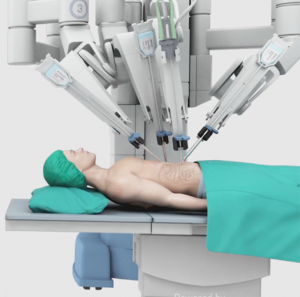
Revolutionizing Gastrointestinal Surgery: The Benefits of Robotic Surgery
In the realm of modern day healthcare, advancements in technology continually push the boundaries of what’s possible, particularly in the field of surgery.
Robotic surgery, once a futuristic concept, has now become a cornerstone of many surgical specialties, including gastro-intestinal surgery. With its ability to achieve greater precision, navigate challenging anatomical landscapes, and cater to patients with higher body mass index (BMI), robotic surgery is revolutionizing how we approach gastrointestinal procedures.

Precision Redefined
One of the most significant advantages of robotic surgery in gastrointestinal procedures lies in its unparalleled precision. Traditional laparoscopic surgery, while minimally invasive, often requires surgeons to maneuver instruments with limited dexterity and range of motion. However, robotic systems provide surgeons with enhanced control and precision through articulated robotic arms and high-definition, magnified 3D imaging.
Overcoming Anatomical Challenges
The gastrointestinal tract presents a complex anatomical landscape with numerous delicate structures intertwined. Conventional laparoscopic surgery can be challenging in such scenarios, especially in cases where the target area is deep-seated or obscured by surrounding organs. Robotic surgery offers a solution to these challenges by providing surgeons with enhanced visualization and maneuverability.
The three-dimensional, high-definition visualization provided by robotic systems allows surgeons to navigate intricate anatomical structures with greater ease and accuracy. This is particularly beneficial in procedures such as hiatal surgery, pelvic & rectal surgeries, where precise dissection around critical structures is essential to preserve vital functions.
By offering a magnified view and articulated instruments that mimic the human wrist’s range of motion, robotic surgery empowers surgeons to perform these procedures with confidence and precision.
Catering to Patients with High BMI
Another notable advantage of robotic surgery in gastrointestinal procedures is its ability to cater to patients with a higher body mass index (BMI). Obesity presents unique challenges in surgery, including limited access to the operative site, increased risk of complications, and technical difficulties in maneuvering instruments within the abdominal cavity.
Robotic surgery mitigates many of these challenges by offering improved access and maneuverability. The longer reach and flexibility of robotic arms enable surgeons to reach deep-seated structures more easily, even in patients with higher BMIs. Additionally, the enhanced visualization provided by robotic systems facilitates better identification of anatomical landmarks, reducing the risk of inadvertent injury and ensuring optimal surgical outcomes.
conclusion:
In conclusion, robotic surgery has emerged as a game-changer in the field of gastrointestinal surgery, offering a multitude of benefits ranging from enhanced precision to improved outcomes in challenging anatomical scenarios and in patients with higher BMIs. By leveraging advanced technology to augment surgical capabilities, robotic systems empower surgeons to perform complex procedures with greater confidence and efficacy, ultimately leading to improved patient outcomes and enhanced quality of care. As technology continues to evolve, the role of robotic surgery in gastro-intestinal procedures is poised to expand, further shaping the future of surgical innovation and patient care.
#RoboticSurgery #BenefitsOfRoboticSurgery #BenefitOfRobot #RoboticSurgeryBenefits #RoboticSurgeryInIndia #RoboticSurgeryInGujarat #RoboticSurgeryInAhmedabad #RoboticSurgeryInZydus #DrVishalSoni #RoboticHerniaSurgery #RoboticHerniaSurgeryInIndia #BenefitsOfRoboticSurgery #AdvantagesOfRoboticSurgery #RobotAssistedSurgery #RobotVsLap #RoboticSurgeryInIndia #LaparoscopicSurgeryVsRoboticSurgery #LaparoscopyVsRoboticSurgery #BestRoboticSurgeonInIndia #BestRoboticSurgeonInGujarat #BestRoboticSurgeonInAhmedabad